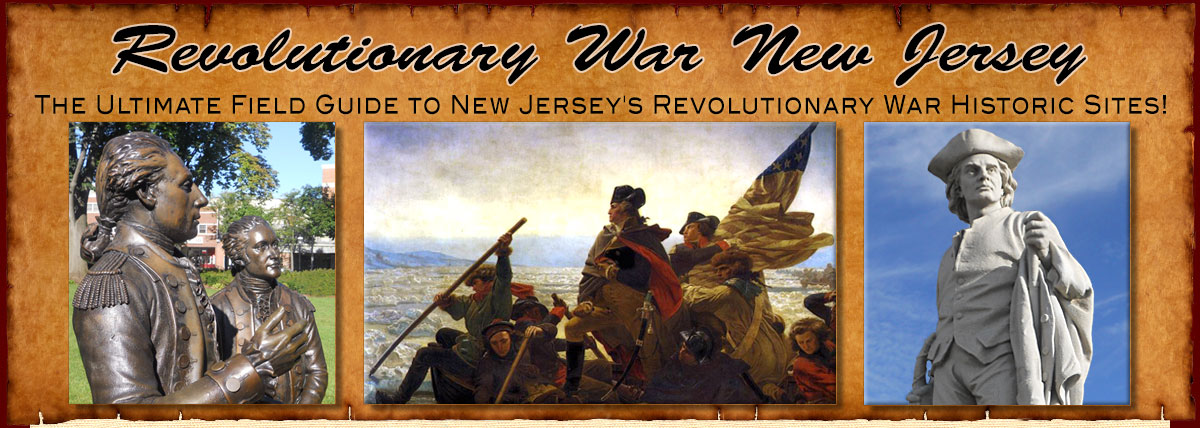

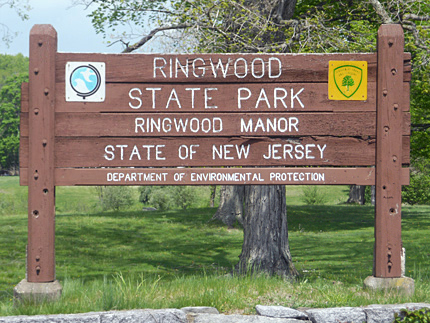
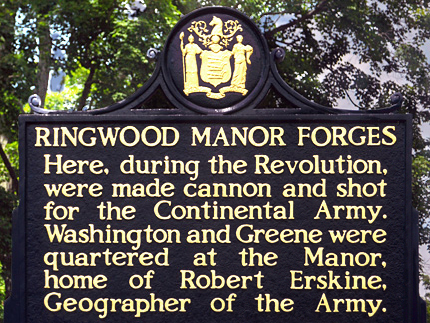
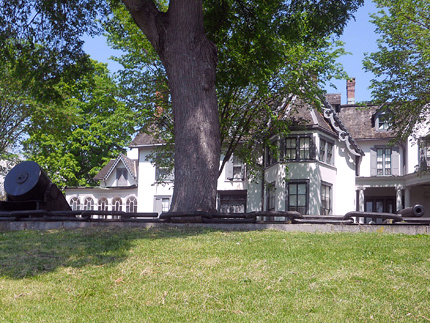
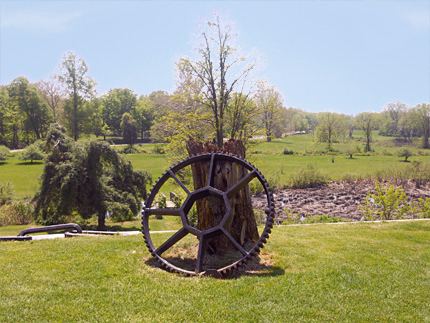
Ringwood State Park
Robert Erskine Gravesite /
Ringwood Manor Forges
1304 Sloatsburg Rd.
Map / Directions to Ringwood State Park
For information about visiting the park, see:
Ringwood Manor Website
and
Ringwood State Park Webpage
During the Revolutionary War, Ringwood Ironworks produced arms and equipment for the Continental (American) Army. At that time, its supervisor was Robert Erskine. Erskine was born in Scotland in 1735 and immigrated to New Jersey in 1771 when he began to manage Ringwood Ironworks as well as the ironworks at Long Pond and Charlotteburg. Erskine played a number of military roles in the Revolutionary War, beginning early in the war in 1775 when he was commissioned the captain of a local militia. He also designed several defensive weapons to hinder the movements of the British navy. [1]
Erskine's most important role in the war, and the one for which he is most remembered, came in July 1777, when he received the important appointment as the first Geographer and Surveyor-General of the Continental Army. In a letter to the Continental Congress on July 19, General George Washington recommended the creation of the position, and that Erskine was the man for the job. Washington wrote; [2]
"A good Geographer to Survey the roads and take sketches of the Country where the Army is to Act would be extremely useful and might be attended with exceeding valuable consequences—He might with propriety have the chief direction of the Guides who must have a head to procure, govern, and pay them. If such a person should be approved of I would beg leave to recommend Mr Robt Erskine who is thoroughly skilled in this business—has already assisted us in making maps of the Country—and has (as I am informed) uniformly supported the Character of a fast friend to America"
Six days later, the Continental Congress approved the appointment of Erskine. [3] As Geographer and Surveyor-General of the Continental Army, Erskine went on to create over 200 maps for Washington and the army.
Robert Erskine did not live to see the end of the Revolutionary War. He became ill on September 18, 1780, while surveying land in the Hudson Highlands. His illness became worse, and he died at Ringwood on October 2, 1780.
General George Washington was at Ringwood on several occasions during the Revolutionary War, both before and after Erskine's death. One of these times was at an extremely tense period during what is known as the Pompton Mutiny. [4]
Note that the historic house in the park, Ringwood Manor, is not the same home that Robert Erskine lived in; it was not built until decades after his death. The first section of Ringwood Manor was built circa 1810, and later additions and renovations were made to the house over the course of the next century. [5] The house is open for tours.
Robert Erskine is buried in the cemetery on the grounds. A large tabletop grave and a boulder monument pay tribute to him. The cemetery also contains the grave of David Dutcher II, who served as a private in the Revolutionary War. [6]There may be other unknown Revolutionary War soldiers buried here in unmarked graves. [7]
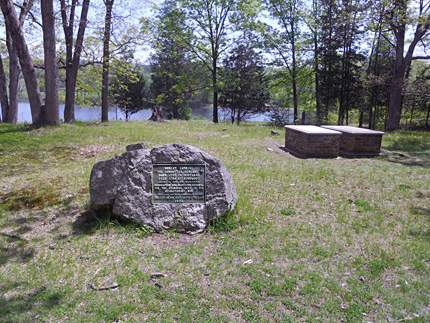
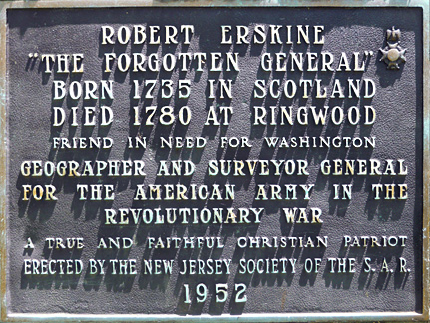
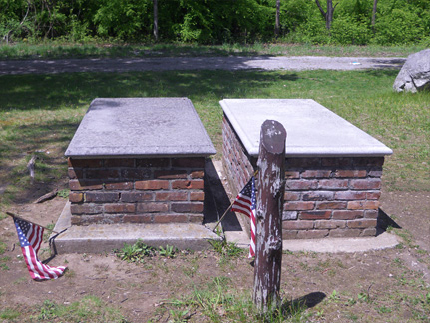
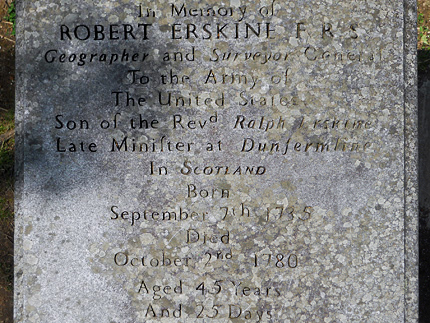

1. ^ Robert Erskine page of the Ringwood Manor website
William S. Stryker, Official Register of the Officers and Men of New Jersey in the Revolutionary War (Trenton: Wm. T. Nicholson & Co., 1872) Page 390
Available to be read at the Internet Archive here
2. ^ “From George Washington to the Continental Congress Committee to Inquire into the State of the Army, 19 July 1777,” Founders Online, National Archives, last modified October 5, 2016, http://founders.archives.gov/documents/Washington/03-10-02-0328. [Original source: The Papers of George Washington, Revolutionary War Series, vol. 10, 11 June 1777 – 18 August 1777, ed. Frank E. Grizzard, Jr. Charlottesville: University Press of Virginia, 2000, pp. 332–337.]
3. ^ Journals of the Continental Congress, Volume VII, May 22 - October 2, 1777 (Washington D.C.: Government Printing Office: 1907) Page 580
Available to be read at Google Books here“From George Washington to Robert Erskine, 28 July 1777,” Founders Online, National Archives, last modified October 5, 2016, http://founders.archives.gov/documents/Washington/03-10-02-0437. [Original source: The Papers of George Washington, Revolutionary War Series, vol. 10, 11 June 1777 – 18 August 1777, ed. Frank E. Grizzard, Jr. Charlottesville: University Press of Virginia, 2000, p. 444.]
“To George Washington from Robert Erskine, 1 August 1777,” Founders Online, National Archives, last modified October 5, 2016, http://founders.archives.gov/documents/Washington/03-10-02-0481. [Original source: The Papers of George Washington, Revolutionary War Series, vol. 10, 11 June 1777 – 18 August 1777, ed. Frank E. Grizzard, Jr. Charlottesville: University Press of Virginia, 2000, pp. 476–479.]
4. ^ The Pompton Mutiny is described in detail on the Bloomingdale page of this website.
The following letters were written by George Washington while at Ringwood during the time of the Pompton Mutiny, and can be read at the Founders Online / National Archives website:
“George Washington to the Commissioners for Redressing the Grievances of the New Jersey Line, 27 January 1781,” Founders Online, National Archives, https://founders.archives.gov/documents/Washington/03-30-02-0247. [Original source: The Papers of George Washington, Revolutionary War Series, vol. 30, 1 January–6 March 1781, ed. Benjamin L. Huggins. Charlottesville: University of Virginia Press, 2022, pp. 277–278.]
“George Washington to William Livingston, 27 January 1781,” Founders Online, National Archives, https://founders.archives.gov/documents/Washington/03-30-02-0250. [Original source: The Papers of George Washington, Revolutionary War Series, vol. 30, 1 January–6 March 1781, ed. Benjamin L. Huggins. Charlottesville: University of Virginia Press, 2022, pp. 283–284.]
“George Washington to the Officer Commanding the New Jersey Line, 27 January 1781,” Founders Online, National Archives, https://founders.archives.gov/documents/Hamilton/01-02-02-1043. [Original source: The Papers of Alexander Hamilton, vol. 2, 1779–1781, ed. Harold C. Syrett. New York: Columbia University Press, 1961, p. 545.]
“George Washington to the Officer Commanding the New Jersey Brigade, 28 January 1781,” Founders Online, National Archives, https://founders.archives.gov/documents/Washington/03-30-02-0258. [Original source: The Papers of George Washington, Revolutionary War Series, vol. 30, 1 January–6 March 1781, ed. Benjamin L. Huggins. Charlottesville: University of Virginia Press, 2022, pp. 294–295.]
“George Washington to Colonel Israel Shreve, 28 January 1781,” Founders Online, National Archives, https://founders.archives.gov/documents/Washington/03-30-02-0259. [Original source: The Papers of George Washington, Revolutionary War Series, vol. 30, 1 January–6 March 1781, ed. Benjamin L. Huggins. Charlottesville: University of Virginia Press, 2022, p. 295.]
Another group of letters written by Washington from an earlier stay at Ringwood is listed below:
“From George Washington to Colonel William Malcom, 5 June 1779,” Founders Online, National Archives, last modified October 5, 2016, http://founders.archives.gov/documents/Washington/03-21-02-0078. [Original source: The Papers of George Washington, Revolutionary War Series, vol. 21, 1 June–31 July 1779, ed. William M. Ferraro. Charlottesville: University of Virginia Press, 2012, p. 81.]
“From George Washington to Major Henry Lee, Jr., 6 June 1779,” Founders Online, National Archives, last modified October 5, 2016, http://founders.archives.gov/documents/Washington/03-21-02-0087. [Original source: The Papers of George Washington, Revolutionary War Series, vol. 21, 1 June–31 July 1779, ed. William M. Ferraro. Charlottesville: University of Virginia Press, 2012, p. 91.]
“From George Washington to the Board of War, 6 June 1779,” Founders Online, National Archives, last modified October 5, 2016, http://founders.archives.gov/documents/Washington/03-21-02-0083. [Original source: The Papers of George Washington, Revolutionary War Series, vol. 21, 1 June–31 July 1779, ed. William M. Ferraro. Charlottesville: University of Virginia Press, 2012, pp. 87–88.]
“From George Washington to Major General Arthur St. Clair, 6 June 1779,” Founders Online, National Archives, last modified October 5, 2016, http://founders.archives.gov/documents/Washington/03-21-02-0089. [Original source: The Papers of George Washington, Revolutionary War Series, vol. 21, 1 June–31 July 1779, ed. William M. Ferraro. Charlottesville: University of Virginia Press, 2012, pp. 92–93.]
“From George Washington to Brigadier General William Irvine, 6 June 1779,” Founders Online, National Archives, last modified October 5, 2016, http://founders.archives.gov/documents/Washington/03-21-02-0085. [Original source: The Papers of George Washington, Revolutionary War Series, vol. 21, 1 June–31 July 1779, ed. William M. Ferraro. Charlottesville: University of Virginia Press, 2012, pp. 88–89.]
“From George Washington to John Jay, 6 June 1779,” Founders Online, National Archives, last modified October 5, 2016, http://founders.archives.gov/documents/Washington/03-21-02-0086. [Original source: The Papers of George Washington, Revolutionary War Series, vol. 21, 1 June–31 July 1779, ed. William M. Ferraro. Charlottesville: University of Virginia Press, 2012, pp. 89–90.]
“From George Washington to Major Henry Lee, Jr., 6 June 1779,” Founders Online, National Archives, last modified October 5, 2016, http://founders.archives.gov/documents/Washington/03-21-02-0087. [Original source: The Papers of George Washington, Revolutionary War Series, vol. 21, 1 June–31 July 1779, ed. William M. Ferraro. Charlottesville: University of Virginia Press, 2012, p. 91.]
5. ^ Details about the history of Ringwood Manor can be found at:
• Architecture page of the Ringwood Manor website
• National Register of Historic Places / Inventory - Nomination Form for Ringwood Manor
Available as a PDF on the National Park Service website here6. ^ Dutcher's modern military gravestone reads:
David Dutcher II
Pvt
Col Swartwout's Regt
Dutchess County Mil
NY Line
December 24, 1759
February 17, 1818